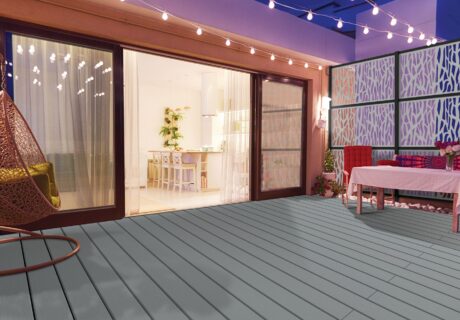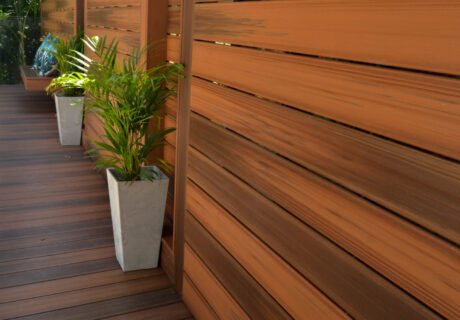Composite decking products have been available since the late 1990’s. Since then, there have been new materials, manufacturing processes and installation techniques that have dramatically improved all three aspects of the category – appearance, performance and price. The reality is that not all composite decking is the same and pricing doesn’t necessarily tell the whole story either. So, what do you look for when choosing which composite decking brands to present to a client?
Here are some of the most important things to look at when comparing the pros and cons of different composite decking materials for your customers.
Compare Composite Decking Raw Materials
Unlike composite decking buyers of the past, contractors have a number of different choices today. Differences abound in everything from colors and textures to stability and comfort underfoot. What they have in common is that fact that all composite decking is made from unique combinations of natural wood fibers and plastic. However, the type of plastic and the product mix varies significantly by manufacturer.
Typically, manufacturers will use either recycled polyethylene, PVC or polypropylene plastic to give the material its superior resistance to moisture and mold growth. In general, these plastic composites will not splinter and crack like pressure treated (PT) wood is prone to do over time.
Because of its widespread availability (and subsequent low price) polyethylene (PE) plastic (the stuff they make milk jugs from) has long been the plastic material of choice for many composite deck makers. However, over the past several years, consumers have begun demanding better performance from the composite decking products they purchase. While not having to paint, sand and stain composites like PT wood, customers are now looking for composite decking materials to have better structural strength, resist fading and staining, and remain cooler underfoot.
Polypropylene (PP), used in Barrette Outdoor Living composite decking products, is much less brittle than PE plastic, making it a stronger material ingredient. Polypropylene plastic’s superior resistance to chemical absorption and high melting point mean that composites made with PP have increased durability, stain resistance, and are cooler underfoot.
Comparing Capped vs Uncapped Composite Decking Products
Earlier, first generation versions of composite decking were often susceptible to damage from everyday use and vulnerable to fading, mold and mildew growth. This was because the composite material was produced using the exact same material configuration throughout the entire depth of the product. Today, high-quality composite decking is capped. Meaning that it has a tough outer layer surrounding the inner material.
Barrette Outdoor Living even goes one step further by installing a proprietary protective film over each board to keep it clean and protected during storage, shipment and installation. Once the composite decking is installed, the protective layer is peeled away, revealing a pristine surface for the homeowner.
Compare Installation Time of Composite Decking Products
Comparing the installation time of composite decking products is something that will be of particular interest to decking professionals. While DIY homeowners will also benefit from building with a composite decking system that installs quickly, the time savings for professional deck builders can have an immediate impact on their business’ bottom line.
What makes composite decking superior to natural wood – it’s high density toughness – can also make cutting and attaching it to framing material more arduous and time consuming. For most composite products, special screws are often required in order to penetrate the deck and attach to the PT wood frame below. Some manufacturers even recommend pre-drilling pilot holes in the composite decking before attempting to drive a screw through it. All these options are labor intensive.
Fortunately, some manufacturers like Barrette Outdoor Living, have alternatives to the traditional screw down method of deck building. These include a number of hidden fastener systems that use clips instead of screws to secure the deck to the frame. The revolutionary Step-Clip™ system from Barrette Outdoor Living, makes installing a deck faster than a traditional nailing and screw system, with no special tools needed!
Plus, the Step-Clip strips protect the top of the joist from water damage, rot and decay, eliminating the need for joist protection tape. It also automatically spaces deck boards uniformly at 3/16″ apart – another huge time saver.
Compare the Appearance of Composite Decking Boards
The first generation of composite decking brands seemed to thrive by making it clear that it was not wood. As a result, earlier composite decking was typically smooth, with little to no variation in either color or texture. Today’s customers are more interested in a product that looks like natural wood.
Today, by intentionally blending different color pigments and other raw materials at precise times during the mixing process, high-quality composite decking can mimic the look of different species of wood.
Compare composite decking warranties
Lastly, composite decking customers are often interested in comparing differences in the warranties offered by competing decking brands. While a homeowner may have no intention of remaining in one house for 15 or 20 years, the fact that they could, and their decking material would still be covered by a warranty – is something that customers value. When it comes to comparing warranties of composite decking products, customers should note not only the duration of the warranty period but also pay attention to what’s covered – and what’s not.
For example, a low-quality product would typically have a shorter warranty period than a product that was expected to last a long time. Otherwise, the manufacturer of the low-quality item would be constantly repairing/replacing items (under warranty) instead of making/selling new products. All Barrette Outdoor Living composite decking includes a 25-year limited stain and fade warranty that also covers the cost of labor required to replace any defective boards within the first 5 years.




